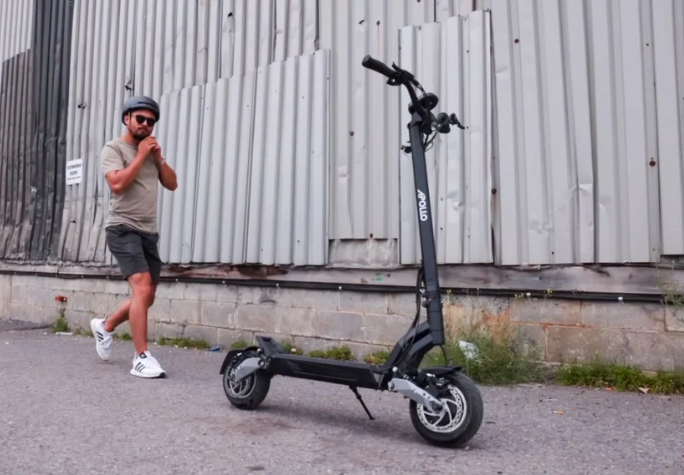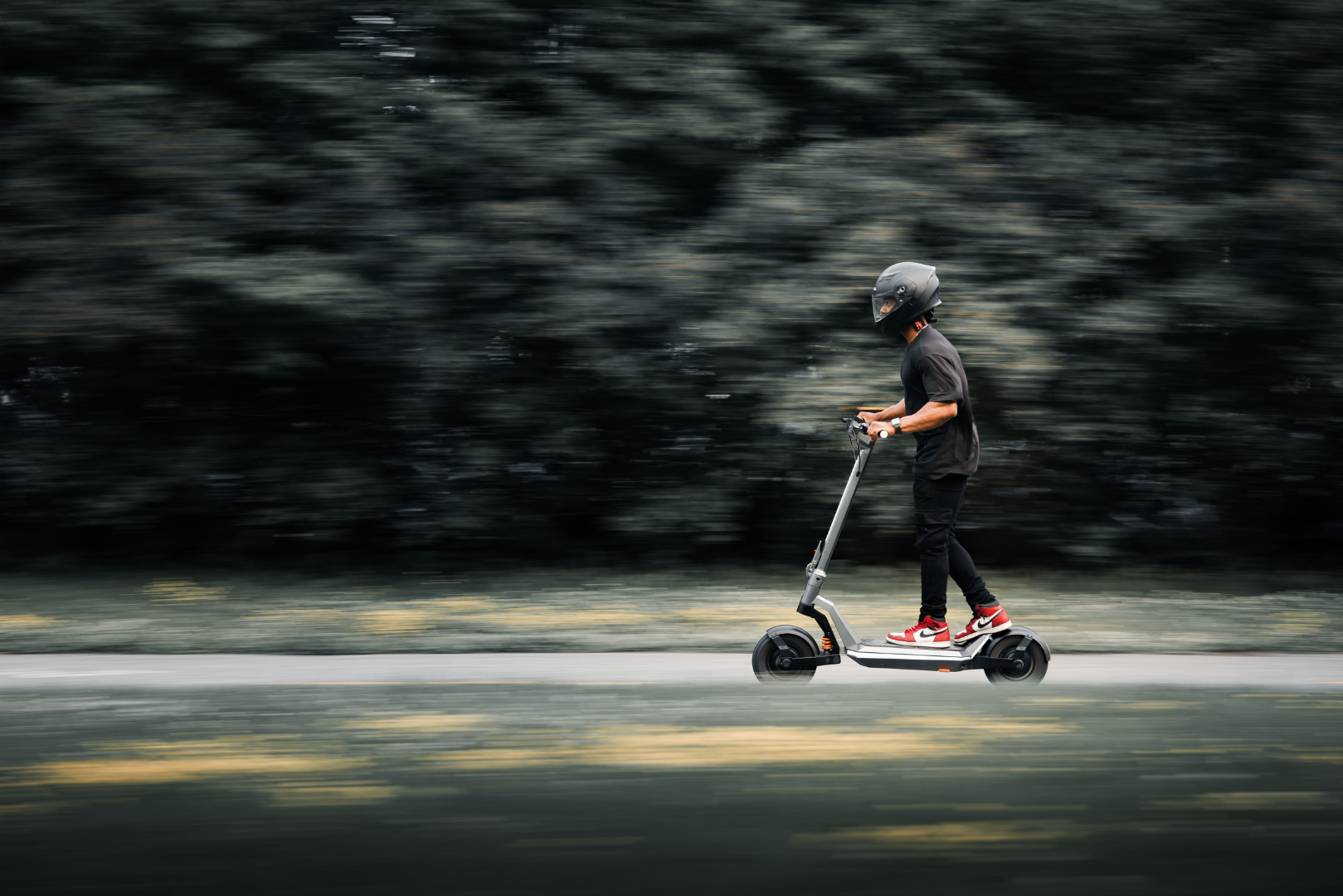Electric Scooter Tire Pressure: A Simple Guide
It might seem strange to focus so much attention on tire pressure when talking about electric scooters. It's just air, right? How much difference could it make?
Maybe we think the important things are battery capacity, high powered motors, state-of-the-art controllers, swag lights, etc. Or maybe we don't think about the parts of our electric scooter at all. We want it to go fast -- and not go flat!
As long as you ride a scooter with pneumatic (that is, air filled) tires, you run the risk of getting a flat. But as we'll see in our simple guide below, not all pneumatic tires are equally at risk. Some are nearly flat proof and self healing. Some are... not.
First, however, let's begin with the most important recommendation:
Check Your Tire Pressure Often
If you ride frequently, check your tires once per week, or every two weeks if you have tubeless tires. If you don't ride frequently, check the pressure and top the tires off before each ride, at least.
If you're storing an electric scooter, try not to ever do so with totally flat tires, as this can damage tubes and tires and make them unusable. Check tires and top off once a month (and make sure to keep the battery charged at around 40-50%).
If you own an electric scooter with air filled tires you should also have an air pump. A bicycle pump will work just fine. If you don't have a pump with a gauge, you can use any tire pressure gauge designed for car or bike tires to keep an eye on your scooter's tire pressure.
Indulge in the exhilaration of speed with the all-new Apollo Pro 2023. Featuring the cutting-edge LUDO Mode, this top-tier electric scooter unleashes the true potential of its 52V system, catapulting you from 0 to 30MPH in an astonishing 4.99 seconds.
What's more, it effortlessly cruises at a remarkable top speed of up to 44 mph. Elevate your ride today with the Apollo Pro 2023 – already available on our store! Pre-order now!
The Average Recommended Tire Pressure for Most Electric Scooter Tires is Around 50 PSI
This number can vary significantly, however, given the range of tire sizes and widths and, as we'll see below, the rider's weight and riding conditions.

Types of Tires
Broadly speaking, there are three kinds of electric scooter tires that come in a variety of widths and diameters. These are:
Solid Tires:
Made of plastic, rubber, polyurethane, and other flexible materials, solid tires can be fully solid or they can be vented or honeycomb tires that absorb some road vibration.
Tubed Pneumatic Tires:
Like the tires on most bicycles, tubed pneumatic tires have inner tubes that can be replaced or repaired when they go flat.
Tubeless Pneumatic Tires:
Just like the tires on your car, tubeless electric scooter tires lack an inner tube. They use air pressure to mount against the rim, and special sealant to keep them from going flat.
Tubeless tires are known to hold air better than tubed tires and so they can be checked less frequently for leaks. When punctured, tubeless tires will lose some air but the sealant inside will usually stop the leak.
Some tubeless tires also contain an additional layer of compound that seals up instantly around punctures. These are known as "self-healing" tires. Apollo has their own self-healing tires which they put to the test in a YouTube video.

The Apollo Air has 10-inch tubed tires that are easy to get off and on for tire/tube changes
Why Does the Kind of Tire Matter?
Obviously, if your tires don't have air, you don't have to worry about air pressure. But solid tires won't give you nearly the same kind of ride quality, traction, and cornering ability as air filled tires.
Believe it or not, pneumatic tires, if you have them, are one of the most important systems on your electric scooter. If they go flat, you aren't going anywhere! If they're at the perfect tire pressure, you can have the ride of your life.
How do you know what the right tire pressure is? That's not easy to answer. It depends on variables like tire type, rider weight, and type of riding. We'll discuss these more in a bit.
It's important to keep in mind that tubeless tires can be run at lower pressures than tubed tires, and they are generally less prone to getting flats. Tubeless tires provide a smoother riding experience than tubed tires but can require a little extra know-how to set up at first.
One general rule of thumb is always:
When in doubt, follow the manufacturer's recommended tire pressure, or the recommended tire pressure printed on the sidewall of the tire.
Why Does Tire Pressure Matter?
Maintaining optimal tire pressure not only reduces the risk of flat tires on the road; it also affects speed, handling, and braking.
Tires in need of air can make your ride feel slow and uncertain, and they decrease the scooter's stopping power. Over inflated tires feel stiff and make cornering at higher speeds less safe.
Better to Use Correct Tire Pressure than Go Too Low or Too High
Finding the right tire pressure can be a challenge for perfectionists, while some riders couldn't care less. Whatever camp you fall into, or in-between, you should avoid extremes of high and low tire pressure.
Under-inflated Tires and Pinch Flats
You run the risk of getting what's called a pinch flat when your tire pressure is too low. Pinch flats happen when the inner tube gets caught between the wheel rim and the bead of the tire, the inner edge that makes contact with the rim.
These punctures leave two little holes behind on the inner tube, which is why they're sometimes known as snakebites.
As you might expect, tubeless pneumatic tires eliminate this problem and can thus be operated at much lower pressure than tires with tubes.
Still, tubeless tires can also suffer when they don't have enough air, becoming mushy, unstable, and unsafe to ride.
Riding at low pressures can also result in uneven and premature tire wear.
Overinflated Tires, Loss of Traction and Stability, and Blow Outs
If your tire pressure is too high, on the other hand, one of your tire's essential functions, keeping you securely on the road, can be compromised.
While adding a few more PSI to your tires might result in a little more range, it also reduces traction, thus making your scooter less predictable when cornering and braking.
Over inflated tires are also at risk of exploding, an event that can be potentially dangerous and that you will be unable to repair on the road.

The EMOVE Cruiser was one of the first electric scooters with tubeless tires
Tubeless Tires and Tire Pressure
As we've mentioned, tubeless tires are not subject to pinch flats and so can be run at lower pressure than tires with tubes. With tubeless, under inflated tires can be an opportunity for a more comfortable ride, especially when riding on rough terrain or off-road.
However, don't lower the tire pressure too much all at once. First try coming down 5-7 PSI from the recommended tire pressure. Then go down 10-15 PSI and see how the scooter feels.
You'll want to make sure you have plenty of sealant, of course, since a tubeless tire can quickly start to lose air if it's too low. With practice, you'll find the optimal tire pressure for you.

The Apollo self-healing tubeless tires
Rider Weight and Tire Pressure
When it comes to rider weight and electric scooter tire pressure, heavier riders will need to inflate their tires to a higher pressure than lighter riders in order to support the added weight.
As a general rule of thumb, for every 10 pounds of weight, add 1 PSI to the recommended tire pressure. However, it's still important to follow the manufacturer's recommended tire pressure as a starting point and adjust as necessary based on your weight and riding style.
As for a reference, you can visit the manufacturer's website or check the user manual that came with your electric scooter. You can also check online forums and communities where electric scooter riders discuss their experiences and recommendations for tire pressure.
It's always a good idea to gather information from multiple sources to get a more comprehensive understanding of what tire pressure is right for your specific scooter model and your individual needs.
Tire Pressure and Off Road Riding
When it comes to off road riding, tire pressure is especially important. Lower tire pressure can provide better traction and handling on rough terrain, but it also increases the risk of punctures and pinch flats. It's important to find the right balance between low enough pressure for a comfortable ride and high enough pressure to prevent flats.
Given the increased risk of punctures, many scooter tires designed for off road riding are tubeless or have the option for a tubeless set up.
FAQs
How Can I Check The Air Pressure in My Electric Scooter's Tire?
You can use a tire pressure gauge for car or bike tires. Any pressure gauge will do, as long as it displays measurements in PSI (pounds per square inch).
Remove the plastic valve cap from the tire valve and attach the air hose to the valve stem. Fill the tire pressure to about 3-5 PSI over the amount you want to inflate to. This overage accounts for the small amount of air lost when you remove the hose from the valve stem.
Why Does Electric Scooter Tire Pressure Matter?
When your tire pressure is too low, your scooter's handling can be mushy and unsafe, and you are at an increased risk of getting flat tires.
Overinflated tires feel stiff and lose traction on the road and they are at greater risk of blow outs if you hit a curb or other relatively steep obstacle.
How to maintain the right tire pressure in your electric scooter
Find the optimal tire pressure for you through trial and error. Start with the manufacturer's recommended tire pressures, then -- depending on your weight, terrain, and riding style -- adjust the pressure slowly as needed up or down.
Some people find a combination of different tire pressures work for them, with different PSI for the front and rear tires.
If you have tubeless tires, you can run them at much lower PSI than tubed tires with no risk of pinch flats, but overinflated tubeless tires can still explode off the wheel rim.
Check your electric scooter tire pressure once or twice a week, at least, to maintain proper tire pressure.
How do I prevent flats on electric scooter tires?
Electric scooter tires are more subject to flats in part because of their small size, so it's important to avoid large obstacles or curbs when you can help it.
You can also use special sealant, even in tubed tires, available in any bike shop that can make your tires more resistant to punctures.
The most important way to prevent flat tires is to perform basic regular tire maintenance: check your tire pressure and check tires regularly for raw spots, tears, or irregularities that might cause them to lose air. If you see any damage to your tire, replace it immediately and do not ride on damaged tires.
How Do I Replace an Electric Scooter Tire?
In most cases, you can replace electric scooter tires yourself by removing the wheel, deflating the tire fully, and removing it with a bicycle tire lever. You can use the same tool to work the new tire onto the scooter rim.
You'll find instructions for replacing your specific electric scooter tires in the manual, on the manufacturer's website, and, most helpfully, in tutorial videos on YouTube.








